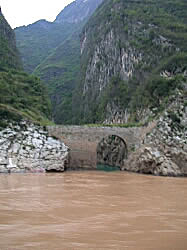 Green
water tributary
Green
water tributary |
Before
leaving home we had read much about China and the Yangtze. We were
pretty much prepared for anything that we might come across. Most
publications we read talked about how polluted the Yangtze River
was and that anything could be found floating in the river. I can't
speak to the water quality of course, but from what we saw there
was very little floating debris in the Yangtze. I was pleasantly
surprised by the lack of floating debris. I expected much more than
what I saw.
There
is one thing you must get used to about the Yangtze, and that is
its dark brown color. It definitely appears to be dirty water. In
the picture to the left you can see a small tributary feeding into
the Yangtze and, just the other side of the bridge, you can see
the beautiful emerald green color of the water. The Yangtze's brown
color is, in fact, its life-giving force. The silt that is being
carried downstream from the mountains and valleys the river passes
through. The amount of silk that accumulates on the river's edge
is amazing. We saw silt deposits that were ten to twenty feet thick
all along the river.
|
|
|
|
|
|
|
|
|
|
|
|
|
|
|
|
|
|
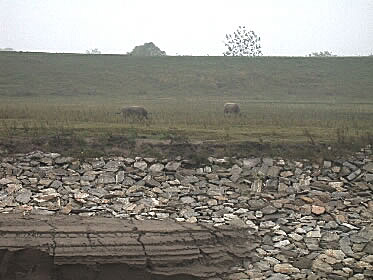 Water
buffalo grazing by silt and the river's edge
Water
buffalo grazing by silt and the river's edge |
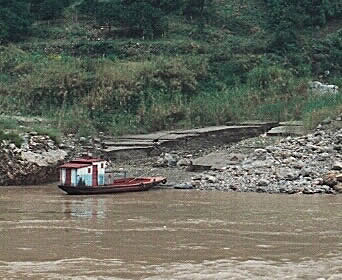 Silt
deposits being mined
Silt
deposits being mined |
|
|
|
|
|
|
|
|
|
|
|
|
|
|
|
|
|
|
|
|
 John,
Carol and Anne enjoying
John,
Carol and Anne enjoying
an evening stroll around the deck |
After
sunset (mind you, not that we ever saw the Sun actually set) we'd
head off for dinner and then take a few turns around the deck. The
weather wasn't cold and it was pleasant. One night we walked past
this cabin (photo right) to see a display of someone's drawers hanging
from the room light and heater. This person was certainly comfortable
sharing such a sight with us! I had to laugh. |
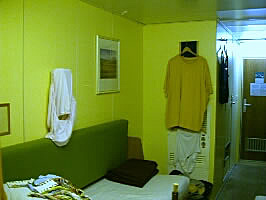 Somebody's
drawers!
Somebody's
drawers! |
|
|
|
|
|
|
|
|
|
|
|
|
|
|
|
|
|
|
|
| We
were awakened early the next morning in preparation for our day excursion
on a sampan up the Da Ning River to view what they call the Lesser
Three Gorges. The scenery along this tributary of the Yangtze is spectacular
and it's emerald green waters were beautiful, much different than
the Yangtze's dark brown that we had become accustomed to. It was
here, however, that I encountered my first disappointment of the trip.
GCT's brochure had billed this as a ride on a sampan, which it was,
but it isn't what I pictured. I pictured a small sampan capable of
holding five or six people and powered by a man pushing a pole along
the river bottom. These were motorized sampans capable of carrying
30 to 40 people, and they weren't nice at all. They were old, decrepit
and in need of repair, not to mention loud. But, I guess, it was the
only way to really see these gorges. Had it been man-powered we would
never have gone as far up the river as we did in the allotted amount
of time. |
|
|
|
|
|
|
|
|
|
|
|
|
|
|
|
|
|
|
|
|
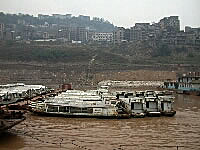 The
sampan fleet
The
sampan fleet |
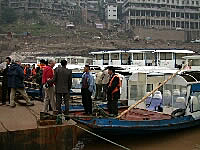 Boarding
the sampan
Boarding
the sampan |
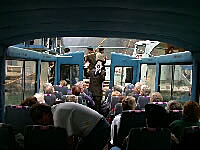 View
from the back
View
from the back |
|
|
|
|
|
|
|
|
|
|
|
|
|
|
|
|
|
|
|
|
|
|
|
|
|
|
|
Scenes
from the sampan on the Da Ning River. The bridge and cave entrance
(1st and 3rd pictures above respectively) will be completely flooded
when the Three Gorges Dam is complete. Much of the splendid
scenery that you are about to see along the Da Ning River will no
longer exist.
|
|
|
|
|
|
|
|
|
|
|
|
|
|
|
|
|
|
|
|
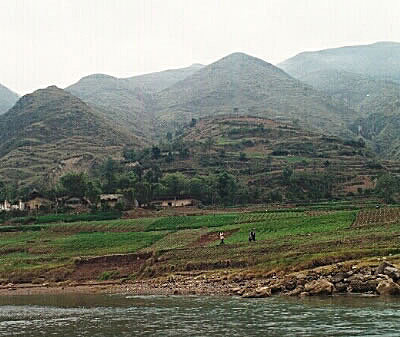 Fertile
crops grow in small plots along the river's edge
Fertile
crops grow in small plots along the river's edge |
The
picture (left) is a common scene along the Yangtze and the Da Ning
rivers ... rich, fertile farmland covered with bright green patches
where crops are planted. As you can see in this picture the crops
are planted in small plots. We saw no evidence of large fields planted
with the same crop as you would see on a farm here in the US. Why?
I can only guess that it has to do with the fact that these farms
are family farms cultivated by hand without the use of any machinery.
The entire time we were in China I never saw a single tractor on any
farm. I saw many people culling the land with plows pulled by water
buffalo and many people working in the fields, but never with any
mechanized assistance. We also saw many orchards growing oranges.
They were beautiful with the oranges showing against the green of
the trees and hills in the background. Unfortunately all of these
farms that we saw will be flooded when the Three Gorges Dam Project
is initially flooded next year. |
|
|
|
|
|
|
|
|
|
|
|
|
|
|
|
|
|
|
|
|
|
|
|
|
Small
sampans, like the ones I thought we'd travel on, were all along
the shore of the Da Ning River
|
|
|
|
|
|
|
|
|
|
|
|
|
|
|
|
|
|
|
|
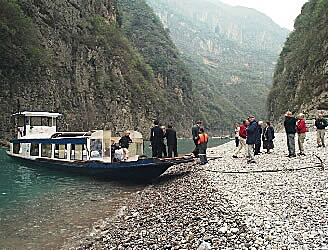 Our
sampan on the rocky shore
Our
sampan on the rocky shore |
We
traveled quite some distance up the Da Ning River passing beautiful
green fields and through many beautiful gorges. Then, at the turnaround
point, they ran our sampan aground on a rocky shore. There we all
left the sampan to explore the beach in search of some beautiful weather-worn
rocks. There were many in all shapes, sizes and beautiful colors.
Everyone grabbed a handful including Anne and I. It's amazing the
boat didn't sink from the added weight of the rocks that we picked
up. When wet they were beautiful colors but dull when they dried off.
Now I have to find a way to get them polished so they retain the beautiful
coloration as if they were wet. I'd be willing to be we've brought
a ton of sea shells and rocks home over the years, but never from
the volcanos in Hawaii as it is believed that taking those rocks brings
bad luck. |
|
|
|
|
|
|
|
|
|
|
|
|
|
|
|
|
|
|
|
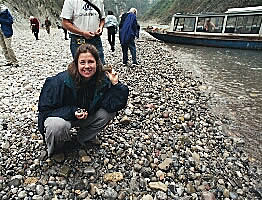 Alicia
showing off a prized rock
Alicia
showing off a prized rock |
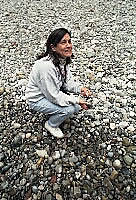 Anne
hunting for the
Anne
hunting for the
perfect addition to
our collection |
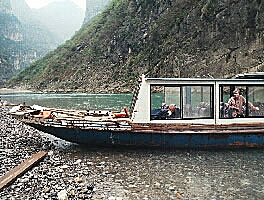 Our
sampan. Frank and Nancy decided
Our
sampan. Frank and Nancy decided
to sit this adventure out, skipping
the walk down the wooden plank, watching our collection efforts
from the sampan |
|
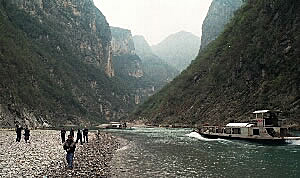 Sampans
pass as we collect rocks
Sampans
pass as we collect rocks |
|
|
|
|
|
|
|
|
|
|
|
|
|
|
|
|
|
|
|
|
Let's
continue to the next page to see the return pictures taken along the
Da Ning River and the Lesser Three Gorges ... |
|
|
|
|
|
|
|
|
|
|
|
|

